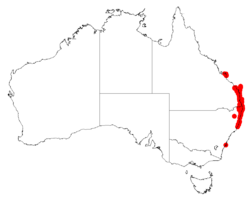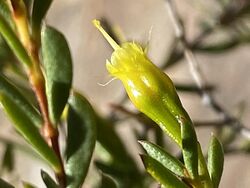Biology:Homoranthus virgatus
| Homoranthus virgatus | |
|---|---|

| |
| Homoranthus virgatus in Broadwater National Park | |
| Scientific classification | |
| Kingdom: | Plantae |
| Clade: | Tracheophytes |
| Clade: | Angiosperms |
| Clade: | Eudicots |
| Clade: | Rosids |
| Order: | Myrtales |
| Family: | Myrtaceae |
| Genus: | Homoranthus |
| Species: | H. virgatus
|
| Binomial name | |
| Homoranthus virgatus A.Cunn. ex Schauer[1]
| |

| |
| Occurrence data from AVH | |
Homoranthus virgatus commonly known as twiggy homoranthus,[2] is a species of flowering plant in the family Myrtaceae and is found growing in coastal areas of northern New South Wales and in Queensland. It is an upright shrub with wand-like branches, aromatic foliage and white to pink flowers in small clusters at the end of branches.[3]
Description
Homoranthus virgatus is an erect small shrub, 0.5–1.5 m (1 ft 8 in–4 ft 11 in) high with smooth, stiff, lateral branches. The leaves are aromatic, arranged in opposite pairs at right angles to the preceding pair, 8–10 mm (0.31–0.39 in) long, and triangular in cross-section. The small, upturned, creamy-white to pink flowers are borne in pairs or fours at the end of branches in the upper leaf axils on a peduncle about 1 mm (0.039 in) long. The calyx tube is five-ribbed with wide, concave bracteoles, and the style extends about 2 mm (0.079 in) beyond the floral tube. Flowering occurs from August to September.[4][5][6]
Taxonomy and naming
Homoranthus virgatus was first formally described in 1843 by Johannes Conrad Schauer from an unpublished description by Allan Cunningham and the description was published in Monographia Myrtacearum Xerocarpicarum.[7][8] The specific epithet (virgatus) is a Latin word meaning "of twigs" or "rodlike".[9]
Distribution and habitat
Twiggy homoranthus grows in semi-shaded or open situations from Byfield and south to Laurieton within 20 km of the coastline. Also on several islands close to the mainland of eastern Australia, e.g. Fraser, Bribie, Morton and Stradbroke Islands.[4]
Conservation status
Widespread, often locally common and well reserved.[4]
References
- ↑ "Homoranthus virgatus". Australian Plant Census. https://biodiversity.org.au/nsl/services/apc-format/display/103909.
- ↑ "Homoranthus virgatus". Department of Environment, Land and Water-Queensland Government. https://apps.des.qld.gov.au/species-search/details/?id=16919.
- ↑ Harden, Gwen J.. "Homoranthus virgatus". Royal Botanic Garden Sydney. http://plantnet.rbgsyd.nsw.gov.au/cgi-bin/NSWfl.pl?page=nswfl&lvl=sp&name=Homoranthus~virgatus. Retrieved 20 August 2018.
- ↑ 4.0 4.1 4.2 Copeland, Lachlan M.; Craven, Lyn A.; Bruhl, Jeremy J. (2011). "A taxonomic review of Homoranthus (Myrtaceae: Chamelaucieae)". Australian Systematic Botany 24 (6): 351. doi:10.1071/SB11015.
- ↑ Peate, Natalie; MacDonald, Gwenda; Talbot, Alice (2011). Grow What Where. Burnley, Victoria: Bloomings Books Pty Ltd. p. 236. ISBN 9781876473556.
- ↑ Blake, Trevor L. (1981). A Guide to Darwinia and Homoranthus. Maroondah, Victoria: Society for Growing Australian Plants. p. 82. ISBN 0909830150.
- ↑ "Homoranthus virgatus". APNI. https://id.biodiversity.org.au/instance/apni/532601. Retrieved 20 August 2018.
- ↑ Schauer, Johannes C. (1843). Monographia Myrtacearum Xerocarpicarum. pp. 193–194. https://babel.hathitrust.org/cgi/pt?id=mdp.39015061404755;view=1up;seq=45. Retrieved 20 August 2018.
- ↑ Brown, Roland Wilbur (1956). The Composition of Scientific Words. Washington, D.C.: Smithsonian Institution Press. p. 174.
External links
Wikidata ☰ Q15367694 entry
 |


